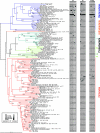Differences between tissue-associated intestinal microfloras of patients with Crohn's disease and ulcerative colitis
- PMID: 16988016
- PMCID: PMC1698347
- DOI: 10.1128/JCM.01004-06
Differences between tissue-associated intestinal microfloras of patients with Crohn's disease and ulcerative colitis
Abstract
A leading hypothesis for the role of bacteria in inflammatory bowel diseases is that an imbalance in normal gut flora is a prerequisite for inflammation. Testing this hypothesis requires comparisons between the microbiota compositions of ulcerative colitis and Crohn's disease patients and those of healthy individuals. In this study, we obtained biopsy samples from patients with Crohn's disease and ulcerative colitis and from healthy controls. Bacterial DNA was extracted from the tissue samples, amplified using universal bacterial 16S rRNA gene primers, and cloned into a plasmid vector. Insert-containing colonies were picked for high-throughput sequencing, and sequence data were analyzed, yielding species-level phylogenetic data. The clone libraries yielded 3,305 sequenced clones, representing 151 operational taxonomical units. There was no significant difference between floras from inflamed and healthy tissues from within the same individual. Proteobacteria were significantly (P = 0.0007) increased in Crohn's disease patients, as were Bacteroidetes (P < 0.0001), while Clostridia were decreased in that group (P < 0.0001) in comparison with the healthy and ulcerative colitis groups, which displayed no significant differences. Thus, the bacterial flora composition of Crohn's patients appears to be significantly altered from that of healthy controls, unlike that of ulcerative colitis patients. Imbalance in flora in Crohn's disease is probably not sufficient to cause inflammation, since microbiotas from inflamed and noninflamed tissues were of similar compositions within the same individual.
Figures

References
-
- Chao, A., R. L. Chazdon, R. K. Colwell, and T.-J. Shen. 2005. A new statistical approach for assessing similarity of species composition with incidence and abundance data. Ecol. Lett. 8:148-159.
-
- Franchimont, D., S. Vermeire, H. El Housni, M. Pierik, K. Van Steen, T. Gustot, E. Quertinmont, M. Abramowicz, A. Van Gossum, J. Deviere, and P. Rutgeerts. 2004. Deficient host-bacteria interactions in inflammatory bowel disease? The Toll-like receptor (TLR)-4 Asp299Gly polymorphism is associated with Crohn's disease and ulcerative colitis. Gut 53:987-992. - PMC - PubMed
Publication types
MeSH terms
LinkOut - more resources
Full Text Sources
Other Literature Sources
Medical
Molecular Biology Databases

